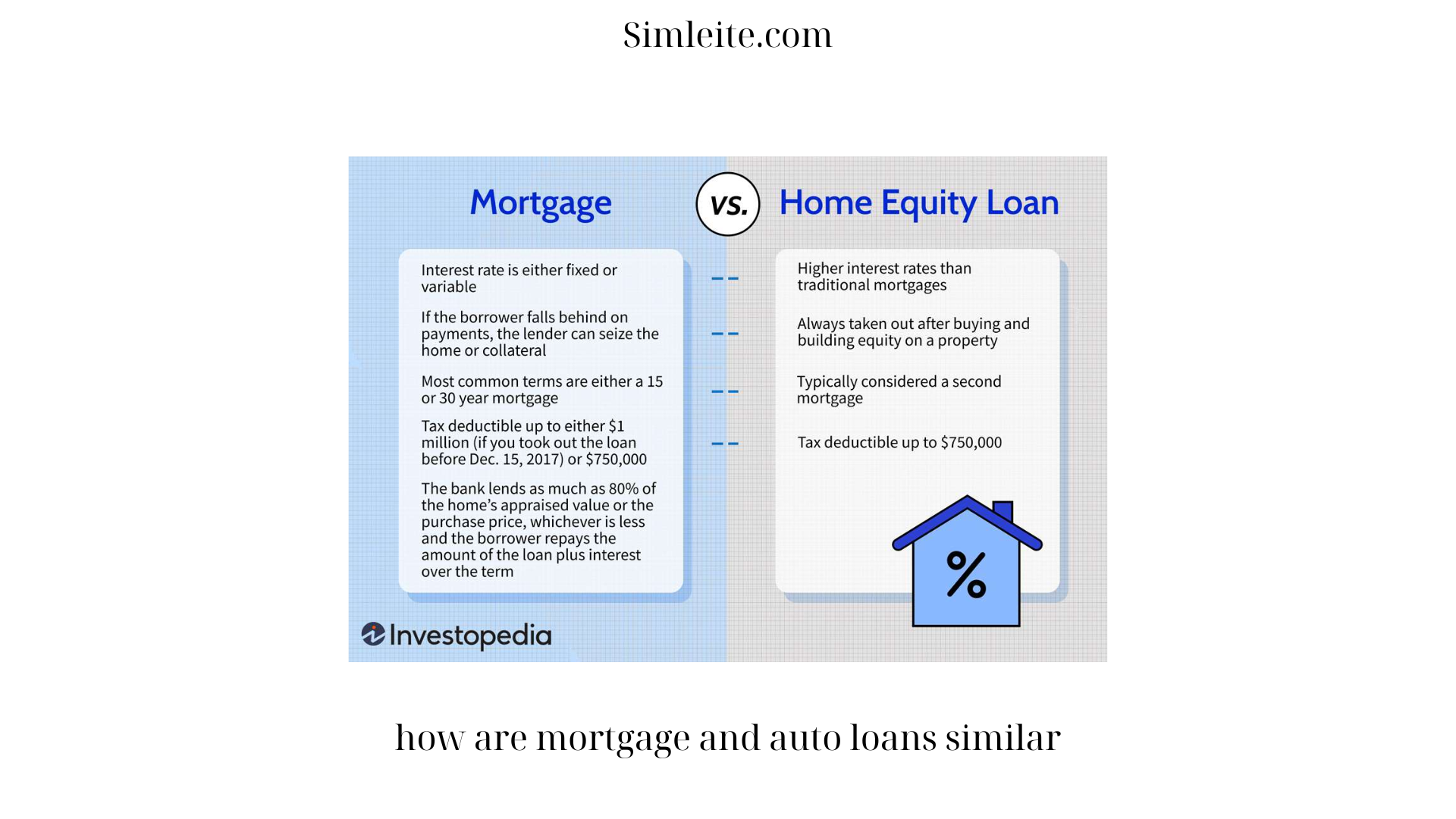How are Mortgage and Auto Loans Similar? Understanding the Overlapping Aspects
Mortgage and auto loans are two common types of loans that individuals often utilize to finance major purchases. While these loans serve different purposes – one for purchasing a home and the other for buying a vehicle – there are several key similarities between them. In this article, Simleite will explore how are mortgage and auto loans similar the overlapping aspects of mortgage and auto loans, shedding light on the shared characteristics that borrowers should be aware of.
How are Mortgage and Auto Loans Similar? Understanding the Overlapping Aspects

- Secured Loans:
Both mortgage and auto loans are secured loans, so how are mortgage and auto loans similar meaning they are backed by collateral. In the case of a mortgage, the home serves as collateral, while in an auto loan, the vehicle being purchased acts as collateral. This arrangement provides lenders with a form of security, as they can repossess the property or vehicle if the borrower fails to repay the loan. - Loan Approval Process:
The approval process for both how are mortgage and auto loans similar involves a thorough assessment of the borrower’s creditworthiness. Lenders evaluate factors such as credit score, income, employment history, and debt-to-income ratio to determine the borrower’s ability to repay the loan. Additionally, both types of loans require documentation such as proof of income, identification, and details about the property or vehicle being financed. - Fixed or Variable Interest Rates:
Mortgage and auto loans offer borrowers the choice between fixed or variable interest rates. Then how are mortgage and auto loans similar? A fixed interest rate remains constant throughout the loan term, providing stability and predictable monthly payments. On the other hand, a variable interest rate fluctuates based on market conditions, which can result in changes to the monthly payment amount over time. Borrowers must carefully consider their financial goals and risk tolerance when selecting between fixed and variable interest rates for both types of loans. - Loan Repayment Terms:
Both mortgage and auto loans come with predetermined repayment terms. Mortgage loans typically have longer terms, often ranging from 15 to 30 years, due to the higher loan amounts involved. So how are mortgage and auto loans similar? Auto loans, on the other hand, typically have shorter terms, typically ranging from 3 to 7 years. However, it is important to note that the exact repayment terms can vary based on factors such as the loan amount, interest rate, and borrower’s creditworthiness. - Amortization:
Mortgage and auto loans follow an amortization schedule, which outlines the repayment plan over the loan term. Amortization involves making regular monthly payments that consist of both principal and interest portions. Initially, a larger portion of the payment goes towards interest, while over time, the principal portion increases. This gradual reduction of the loan balance results in the eventual full repayment of the loan. - Prepayment Penalties:
Both mortgage and auto loans may come with prepayment penalties, although their prevalence varies. Prepayment penalties are fees charged by lenders if borrowers repay the loan before its scheduled term. How are mortgage and auto loans similar? These penalties are meant to compensate lenders for potential lost interest due to early repayment. Borrowers should carefully review the loan terms and conditions to determine if prepayment penalties apply and factor them into their decision-making process.

- Impact on Credit Score:
Both mortgage and auto loans have the potential to impact a borrower’s credit score. Timely payments and responsible management of these loans can positively contribute to a borrower’s credit history, demonstrating their ability to handle debt. Conversely, missed or late payments can negatively impact the credit score. Borrowers should prioritize making payments on time to maintain a healthy credit profile. - Refinancing Options:
Both mortgage and auto loans offer borrowers the option to refinance their loans. Refinancing involves replacing an existing loan with a new one, often with more favorable terms. Borrowers may choose to refinance to obtain a lower interest rate, extend the loan term, or change the loan structure. Refinancing can potentially result in reduced monthly payments or savings on interest expenses. - Legal and Financial Implications:
Both mortgage and auto loans have legal and financial implications for borrowers. So how are mortgage and auto loans similar? Before entering into these loan agreements, borrowers should carefully review and understand the terms and conditions, including the rights and responsibilities of both parties. Failure to meet the obligations outlined in the loan agreement can have legal consequences, including foreclosure for mortgage loans or repossession for auto loans. - Importance of Responsible Borrowing:
Understanding the similarities between mortgage and auto loans highlights the importance of responsible borrowing. Borrowers should carefully consider their financial situation, budget, and long-term goals when taking on debt. It is crucial to assess the affordability of loan payments and ensure that they fit within the overall financial plan. Responsible borrowing practices help borrowers avoid financial strain and maintain a healthy financial future.

Conclusion:
While mortgage and auto loans serve different purposes, they share several key similarities. Understanding the overlapping aspects of these loans, such as being secured loans, the loan approval process, interest rates, repayment terms, and the impact on credit scores, empowers borrowers to make informed decisions. By recognizing how are mortgage and auto loans similar the similarities and responsibly managing these loans, borrowers can navigate the borrowing process with confidence and achieve their financial goals.